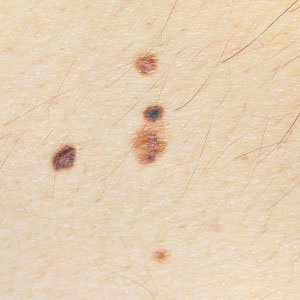Removing Moles by Yourself Can Be Dangerous
Before you use that “guaranteed” mole remover cream or decide to perform surgery on yourself by cutting off that offending mole with a razor blade—take a few minutes to read about the health and cosmetic consequences of using so-called removal creams or cutting instruments on that bothersome mole.
Moles can develop anywhere on your body for a number of reasons. Initially, people who have more than two or three moles dotting their skin may have a genetic predisposition for acquiring moles. Additionally, spending a lot of time in the sun can cause “mole” genes to spring into action, meaning people with an inherited tendency to exhibit numerous moles could have ten or more moles covering the back and chest, two of the most common places for moles to proliferate.
Two Common Types of Moles
Okay—So Why Shouldn’t I Remove My Moles at Home?
Moles are not simply overactive skin growths that can be easily removed, like a callus or skin tag. Instead, moles are clusters of pigment cells (melanocytes) that accumulate in a small area and develop into moles. Normally, melanocytes spread throughout the epidermal layer of our skin to give us our normal skin color. When sunlight strikes pigment cells, the cells attempt to absorb the harmful effects of ultraviolet radiation by congregating. This helps improve their ability to prevent UV rays from damaging skin cell DNA, the primary reason behind melanoma development. Consequently, these pigment cells evolve into darker areas on the skin—moles—but not all moles are black or brown. Some can be tan, pink or flesh-colored so that you may not see them right away.
Unlike warts, cutting into a mole will not cause bleeding. However, they will bleed if they are torn away from the skin or if your attempts at excising a mole reaches the area where the mole meets the skin. Since moles primarily consist of melanocytes, bleeding won’t occur if you slice off the uppermost layer of a mole. Try to remove the mole at its base and you will see profuse bleeding simply because you have made contact with capillaries in the skin.
When you choose to remove a mole at home using some kind of cutting instrument, you will risk scarring and infection. In addition, you won’t remove all of the accumulated pigmented cells since you aren’t a professional dermatologist, which means the mole will probably redevelop and present an even darker shade than its previous color.
By taking mole removal into your own hands, you risk:
Removing Moles That May Be Cancerous
Unless you know how to tell the difference between a cancerous mole and a benign mole, you could be removing a mole harboring cancerous activity. Cancer cells are cells that, for a variety of reasons, have begun reproducing at a highly accelerated rate, creating tumors and damaging healthy body tissues. Essentially, a normal cell becomes cancerous when genetic material within the cell undergoes a mutation that changes “proto-oncogenes” to “oncogenes”. Oncogenes are responsible for causing abnormal cell reproduction and division. In addition, another type of gene that prevents tumors from developing is suppressed due to oncogenes. Consequently, DNA is unable to repair itself, freely allowing cancerous conditions to emerge.
When a dermatologist removes moles they suspect are cancerous, biopsies of the moles can accurately identify abnormal cells within moles before the cancer spreads further into the skin. Just because you excise a mole to the point of removing all visible parts of the mole doesn’t mean you have successfully eliminated cancer cells.
Facts about Mole Removal Creams
Depending on where you apply mole removal cream, the results could leave you with a bad scar or indentation that looks worse than the original mole. Mole removal creams contain “natural” ingredients formulated to trick your immune system into believing that the skin is suffering damage. Stimulating the immune system floods the mole with white blood cells intended to facilitate healing of the supposed damage. However, since no real skin problem exists, the inflammation produced by the immune system is unnecessary, resulting in “overhealing” of the mole and skin surrounding it. Unsightly impressions resembling the scarring and pitting associated with acne often develop from the use of mole removal creams. Additionally, many of these creams state that you can speed up the removal process by using an emery board to eliminate layers of the mole, an action that will definitely exacerbate scarring, inflammation and possibly promote infection.
Mayoral Dermatology strongly advises you do not use mole removal creams. They don’t work, they can leave scars and pits and you really don’t know what kind of “natural” ingredients are in the cream since many of them are not regulated by the FDA.
Safe and Effective Mole Removal Techniques
To safely and permanently remove unsightly or bothersome moles, contact Mayoral Dermatology to schedule a consultation with one of our licensed dermatological specialists. Depending on the kind of moles you have, we will recommend the most appropriate mole removal technique, perform biopsies on suspect moles and discuss further procedures you may need if the mole is found to contain abnormalities.
Cryotherapy is one of the most common treatment methods we perform in our state-of-the-art facility to remove benign, atypical and malignant moles. Having your moles removed professionally in a clean, modern environment means the risk of infection is nonexistent and the chance of mole regrowth is minimal to none. Additionally, we will be able to detect evidence of precancerous or cancerous activity in moles we remove via biopsy if they are irregularly shaped, have a scaly, crusty appearance or otherwise present signs that indicate cancer.
Your skin—and your life–are much too important to allow questionable creams or sharp instruments take precedent over having a licensed dermatologist treat unwanted moles. Call us today to make an appointment to have moles removed safely and professionally.


